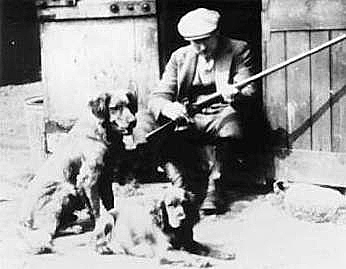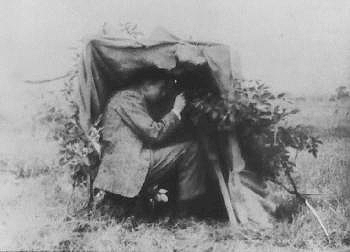Much of the open land between Boothstown village and the Bridgewater Canal to the south disappeared as a result of housing developments in the 1990s. South of the canal, however, there remains a large area extending to the M62 motorway which is not only undeveloped, but which is largely inaccessible. This area of reclaimed mossland represents a welcome wedge of open land on the western side of the Manchester conurbation.
The best known part of the moss is Chat Moss, which represented an enormous challenge to George Stephenson when he built the Manchester to Liverpool railway in the 1820s. Chat Moss was described by Daniel Defoe in the 1720s as follows:
From hence [Warrington], on the road to Manchester, we passed the great bog or waste called Chatmos, the first of that kind that we see in England, from any of the south parts hither. It extends on the left-hand of the road for five or six miles east and west, and they told us it was, in some places, seven or eight miles from north to south. The nature of these mosses, for we found there are many of them in this country, is this, and you will take this for a description of all the rest. The surface, at a distance, looks black and dirty, and is indeed frightful to think of, for it will bear neither horse or man, unless in an exceedingly dry season, and then not so as to be passable, or that any one should travel over them. What nature meant by such a useless production, ’tis hard to imagine; but the land is entirely waste, except for the poor cottager’s fuel, and the quantity used for that is very small.
More recently, memories of the bleakness of the moss inspired the piece Chat Moss (1993) by the composer Sir Peter Maxwell Davies. Chat Moss is believed to be about 7,000 years old, and successful reclamation did not occur until the late 18th century. By 1849 some 800 hectares (about one third of the moss) had been reclaimed.*
To the north of Stephenson’s railway, and south of the Bridgewater Canal at Boothstown, there are three distinct areas:

Secondly, a little to the west of Boothstown, towards Astley, the area south of the canal is scarred by the remains of open cast mine workings. Until fairly recently much of this area was barren (below), and it is now part of a landfill site, where regeneration of previously barren areas is being undertaken.

Thirdly, to the south of Malkins Wood Farm beyond Shaw Brook, and extending east towards Worsley is an area of woodland known as Botany Bay Wood. Shaw Brook (pictured below) is fed by a stream called Sniggly Ditch, thus called because it once abounded in young eels, known in Lancashire as snigs, and appreciated for the making of snig pie.

During the construction of the Bridgewater Canal, Botany Bay Wood was planted on an area used to dump spoils from the canal workings. Moss Canal, an arm of the Bridgewater Canal which ran south towards the wood until this century, was used to carry waste from the canal workings to the area of the wood. The name was given to the wood by the workers, who felt so remote that they might have been in Botany Bay itself.
Part of Botany Bay Wood lies on Worsley Moss, where the remains of ‘Worsley Man’ were found in 1958 (his skull is pictured, below). He is believed to have lived in the second century BC, and to have been the victim of a human sacrifice. It is thought that he was garrotted, and had his throat cut before he was left in the moss.

From the canal at Boothstown, it is possible to look across this landscape, but there is no public access to the two farms, nor to Botany Bay Wood. You should not think of entering the area, as much of the land is protected by a gamekeeper, and by the farmers’ large dogs. There are no roads other than the roughest tracks. The picture below shows Bill Johnson, the gamekeeper around the 1950s.

In the year 1299 Henry de Worsley, Lord of the Manor of Worsley, granted to Robert de Worsley, his son by his second wife, the land to the south of Boothstown, then called Mokens. It stretched from the boundary of Astley in the west, to Irlam in the south, and to the Hollin Wood in the north-east. In 1413 John Booth of Barton ’caused waste by felling and carrying away eighty oaks worth six shillings and eight pence each in a certain wood called Mokens.’ Today this area is known as Malkin’s Wood.
Early in the 19th century it was acquired along with Booth’s Hall by Robert Haldane Bradshaw, Superintendent of the Bridgewater Trust. Upon his retirement, Bradshaw sold the land to the 1st Earl of Ellesmere (then Lord Francis Egerton). The 1st Earl founded the modern farms (Malkins Wood farmhouse dates from around 1850), with Malkins Wood Farm originally intended as a rabbitry, and Grange Farm (now adjacent to the M60 motorway in Worsley) established as a model dairy farm.
The land passed from the earls of Ellesmere to Bridgewater Estates Ltd. when that company was founded in 1923. The land continued to be let to tenant farmers. Shooting rights, formerly for the use of the noble family, were let to businessmen. The whole game reserve of woodland and farmland, protected from trespass and development, has become a wildlife sanctuary. In the wood are foxes and deer; rabbits and hares may be seen in the fields and margins; there are water voles and a rich variety of birdlife; the rare white mole has been seen, while the common mole abounds.
Between the wars, there were magnificent views from the canal bank of lime trees along the main approach to Malkins Wood Farm. Sadly, the lime trees were cut down during the war. In the 1940s, Leslie Turner (pictured below), a local bird photographer with a national reputation, was granted access to the preserved area. On one windy occasion, while studying nestlings, he joined by rope the tree containing the nest with an adjacent tree into which he climbed, so that both trees moved together and kept his focus constant. A newspaper or magazine photograph of a woodland bird in the 1950s or 1960s was likely to have been taken by Turner in Botany Bay Wood.

Much to the surprise of Leslie Turner, there was once an elephant in the wood, though admittedly it was dead! It had been known as Lil when it gave rides to children at Belle Vue zoo in Manchester, and upon its death it was arranged that Manchester University would have the skeleton. The private woodland so close to the city was an ideal place to allow the flesh to be devoured by the insects, birds and animals, away from the knowledge of a sentimental public.
Today the farmland and woodland provide a green oasis bounded by the rapidly expanding conurbation. Limited access has ensured that the area remains unspoilt, and the expanse of moss and farmland is visible from the trunk roads and motorways. The area provides a refreshing back-drop to the canal, and is enjoyed by all local residents. It is to be hoped that this valuable environmental resource will be protected for the benefit of future generations, and that there is the will to resist the pressures for development which have obliterated other large areas of open land in the last thirty years.
Since 1998 there has been a proposal by Peel Holdings to develop a racecourse in the area of Malkins Wood Farm. This was subject to a planning inquiry, and the proposal was rejected in January 2010 by the Secretary of State..
On 3 July 2003, the Salford Advertiser newspaper carried a report about the threat to the environment of Chat Moss. It read:
The battle is on to save Salford’s countryside. The farmers of Chat Moss are under threat, and at last week’s full council meeting councillors threw their weight behind a campaign to save them. Also at the meeting Cllr Roger Jones proposed a motion to support the farmers, stressing that the high quality land would turn into nothing but a bog or building site if it was left to the mercy of peat extraction companies and developers. He said that the distinctive countryside makes up a fifth of Salford’s geographical area. Of the 54 farmers still working on Chat Moss only three are still growing vegetables, because mass suppliers now dominate the produce market. He said, “The bottom line is we’ve already seen off most of the farmers, and in a couple of years we will have seen the rest off. If in 40 or 50 years time there are no more farmers and all the top soil has been stripped off, what will we be leaving for our children? There’s going to be nothing but a big bog.” He added that developers Peel Holdings have their eyes on the site and would be prepared to wait years while the moss was run into a bog so they could move in and build there. He appealed to the council to actively preserve the moss by finding ways to buy the local farmers’ produce and making sure the land was not sold off. Seconding the motion, Cllr Eddie Sheehy added that buying produce from local farmers would bring great environmental benefits by reducing the distance food had to be transported. The motion received enthusiastic support from members of all parties.
Acknowledgements
Recollections of Malkins Wood Farm were provided by Mrs. C.E. Mullineux. Special thanks to Mr. and Mrs. John Topp, formerly of Malkins Wood Farm. All words on this page by TS and C.E. Mullineux (c) copyright, except quotation from Daniel Defoe’s A Tour Through the Whole Island of Great Britain, published by Pengiun Classics, edited by Pat Rogers. Colour photographs copyright (c) TS, black and white photographs supplied by Mrs. Mullineux.
* Historical notes on Chat Moss derived from The Origins of Lancashire by D. Kenyon, Manchester University Press, 1991.